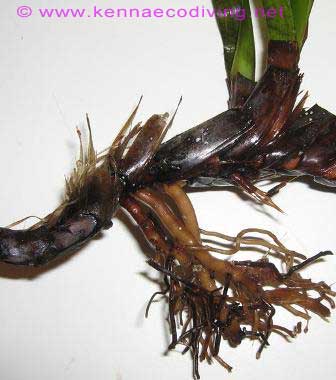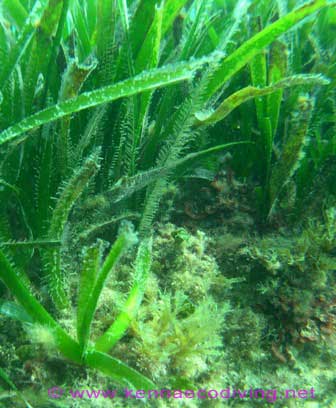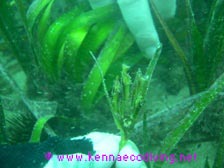Posidonia oceanica (Linnaeus) Delile
Introduction
Posidonia oceanica (L.) Delile is a seagrass species endemic to the Mediterranean Sea that forms dense and extensive underwater meadows with leaves that can attain 1 metre in height. These meadows provide important ecological functions and services and support a highly diverse community, including species of economic interest.
Since the 1970´s, a worldwide decline of seagrass distribution and abundance has been detected and causes are mainly attributed to the negative influence of anthropogenic impacts (Orth et al. 2006[1]). P. oceanica is very sensitive to specific impacts such as bottom trawling [2], anchoring [3], coastal constructions [4], chemical wastes [5], fish farm effluents [6],[7],[8], desalination plants [9], geodynamic alterations [10], biological invasions [11] and many others. The effect of these impacts, alone or combined; cause either a loss of vegetated areas, a reduction in seagrass abundance (cover and/or shoot density) or a deterioration of plant health.
P. oceanica beds are identified as a priority habitat for conservation under the European Union’s Habitats Directive (Dir 92/43/CEE). Conservation management is mainly focused on protection from physical damage through the installation of artificial reefs and seagrass-friendly moorings for boats, which reduce the erosive pressure of otter-trawling and free anchoring in shallow meadows. The control of invasive species has also been performed recurrently in some P. oceanica beds.
Regressed meadows are prone to invasion by one or more of the potential substitutes for P. oceanica [12], [13] such as the other common Mediterranean seagrass Cymodocea nodosa (Ucria) Ascherson, the native Mediterranean green alga Caulerpa prolifera (Forsskal) Lamouroux and the two alien green algae Caulerpa taxifolia (Vahl) C. Agardh and Caulerpa racemosa (Forskal) J. Agardh.
There is a need to further develop regulations for activities that have a negative impact on P. oceanica beds (e.g. pollutants level limits and allowed minimum distances of impact sources to meadows) and to implement them through a vigilance system that is coordinated with the existing seagrass monitoring networks.
Once the cause of habitat perturbation is eliminated, the slow growth of P. oceanica beds means that recovery can take centuries. Measures like remediation of seagrass sediments enriched with organic matter, or transplanting of P. oceanica, are at an experimental stage.
Morphology
Like other angiosperms P. oceanica has roots, stems, leaves, flowers and fruits. At the base of each plant is a rhizome, which is actually a modification of the stem. The rhizomes of P. oceanica can easily be distinguished from those of the other three European seagrass species by the dense, hairy remains of old, degrading leaf sheaths found around the rhizomes. These remains can also be found as conspicuous balls of fibres washed onto the beaches, known as egagropili.
Vertical rhizomes are attached to horizontal rhizomes that branch and expand by terminal apices. Rhizome internodes are short (0.5 to 2 mm) reflecting the slow horizontal growth of the plant, and the thickness of the rhizomes vary between 5 and 10 mm. The roots are 3-4 mm thick, up to 40 cm long and richly branched, attaching the plant to the substratum and allowing the absorption of nutrients from the sediment. Nutrients are taken up from the sediments by the roots and transported to the meristems and leaves for growth. Leaves themselves can also absorb nutrients, and are the main structures for absorbing carbon dioxide CO2 from the water column. Leaf life span in P. oceanica is almost a year with shoots living for decades.
P. oceanica has leaf bundles consisting of 5 to 10 leaves attached to a vertical rhizome. The leaves are broad (5 to 12 mm) and the length usually varies from 20 to 40 cm in length, but may be up to 1 m. A section of the petiole of a leaf shows a true network of lacunae throughout the plant from the tip of the leaf to the end of the roots, called the aerarium, and all the tissues are steeped in gas. This is the main difference between the marine phanerogams and other marine vegetation, which never left the sea.
The rate of formation of seagrass leaves, rhizomes and roots depends on the activity of meristems, where active cell division takes place. The horizontal growth and vertical extension of P. oceanica rhizomes is at a rate of only a few centimetres per year, producing, on average, a branch every 30 years. Shoots produce new leaves every 50 days on average.
The vascular and lacunal systems of the roots and rhizomes facilitate the transport and exchange of fluids and gasses respectively. A proportion of the oxygen O2 that is produced in the leaves during photosynthesis is diverted to the lacunae in the leaves, and then diffuses through the rhizomes to the roots. Some of the O2 diffuses out of the roots to maintain less hypoxic conditions around the rhizosphere. Seagrasses growing in normally hypoxic or anoxic sediments are dependent on transporting sufficient O2 down to their roots to maintain aerobic respiration and to reduce sulphide formation around the roots.
When factors that negatively inhibit O2 production, such as low light, occur simultaneously with factors that increase the O2 demand, such as increased organic loading of the sediments, the risk of sudden, dramatic loss of seagrass beds is increased, accelerated by the further increase in O2 demand created when the dead plant material is degraded.
Propagation
P. oceanica flowers between August and November. The number of shoots flowering in meadows is generally lower than 3 % per year. However, massive flowering events (more than 10% shoots flowering) have been observed associated with extremely warm summers. Flowering intensity is negatively correlated with water depth.
P. oceanica flowers are yellow and can produce half a dozen seeds per shoot. Fruit are large (10 mm) and known as sea olives. Many female flowers do not develop viable fruits due to abortion and predation, and actual seed production is less than 1% of potential. Among the European seagrasses, only P. oceanica has buoyant seeds capable of long-range (10’s of km) dispersal. Nonetheless, young individuals originating from seedlings are rarely found and P. oceanica primarily propagates vegetatively by elongating the rhizomes; a whole meadow may be one single clone resulting from one ancient seedling.
The little investment and low success of sexual reproduction, combined with the extremely slow clonal spread explains the extremely slow colonisation rate of P. oceanica plants. Numerical models simulating the occupation of space by a P. oceanica meadow indicate that it would need 600 years to cover 66 % of the available space around the Mediterranean coastal strip at depths in which it is able to grow. Similar colonisation time scales have been retrospectively calculated based on patch size and patch growth rate in patchy P. oceanica meadows. The very long time scales for colonisation of this species indicate that recovery of disturbed meadows, where important plant losses have occurred, would involve several centuries.
Related articles
References
- ↑ Orth R. J., Carruthers T. J. B., Dennison W. C., Duarte C. M., Fourqurean J. W., Heck JR. K I., Hughes A. R., Kendrick G. A., Kenworthy W. J., Olyarnik S., Short F. T., Waycott M., Williams S. I., (2006) - A global crisis for seagrass ecosystems. Bioscience, 56: 987-996.
- ↑ Sánchez Jerez P., Ramos Esplá A. A.. (1996) - Detection of environmental impacts by bottom trawling on Posidonia oceanica (L) Delile meadows: sensitivitiy of fish and macroinvertebrate communities. Journal of Ecosystem Health, 5: 239-253.
- ↑ Francour P., Ganteaume A., Poulain M. (1999) - Effects of boat anchoring in Posidonia oceanica seagrass beds in the Port-Cros National Park (NW Mediterranean Sea). Aquatic Conserv: Mar. Frshw. Ecosyst., 9: 391-400.
- ↑ Ruiz J. M. , Romero J. Effects of disturbances caused by coastal constructions on spatial structure, growth dynamics and photosynthesis of the seagrass Posidonia oceanica. Marine pollution bulletin, 2003, vol. 46, no12, pp. 1523-1533
- ↑ Pergent-Martini C., Pergent G. (1995) - Impact of a sewage treatment plant on the Posidonia oceanica meadow: assessment criteria. Proceeding of the Second International Conference on the Mediterranean Coastal Environment MEDCOAST. 95: 1389.1399.
- ↑ Delgado O., Ruiz J. M., Pérez M., Romero J., Ballesteros E. (1999) - Effects of fish farming on seagrass (Posidonia oceanica) beds in a Mediterranean bay: seagrass decline after organic matter cessation. Oceanol. Acta, 22(1): 109-117.
- ↑ Ruiz, J.M., Perez, M., Romero, J. Effects of fish farm loadings on seagrass (Posidonia oceanica) distribution, growth and photosynthesis. Mar Pollut Bull. 2001 Sep;42(9):749-760.
- ↑ Pergent-Martini C., Boudouresque C. F., Pasqualini V., Pergent G. (2006) - Impact of fish farming facilities on Posidonia oceanica meadows: a review. Marine Ecology, 27: 310-319.
- ↑ Gacia E., Invers O., Manzanera M., Ballesteros E., Romero J. (in press) – Impact of the brine from a desalination plant on shallow seagrass (Posidonia oceanica) meadow. Estuar. Coast. Shelf Sci.
- ↑ Badalamenti F., Di Carlo G., D´Anna G., Gristina M., Toccaceli M. (2006) – Effects of dredging activities on population dynamics of Posidonia oceanica (L.) Delile in the Mediterranean Sea: The Case Study of Capo Feto (SW Scicily, Italy), Hydrobiologica, 555: 253-261.
- ↑ Villèle DE X., Verlaque M. (1995) – Changes and degredation in a Posidonia oceanica bed invaded by the introduced tropical alga Caulerpa taxifolia in the North Western Mediterranean. Bot Mar., 38: 1-9.
- ↑ Bianchi C.N., Pierano A. (1995) Atlanta delle fanerogame della Liguria: Posidonia oceanica e Cymodocea nodosa. ENEA, Centro Ricerche Ambiente Marino, La Spezia: 146 p.
- ↑ Montefalcone M., Albertelli G., Bianchi C. N., Mariani M., Morri C. (2006) A new synthetic index and a protocol for monitoring the status of Posidonia oceanica meadows: a case study at Sanremo (Ligurian Sea, NW Mediterranean) Aquat. Conserv., 16(1): 29-42.
Please note that others may also have edited the contents of this article.
|


